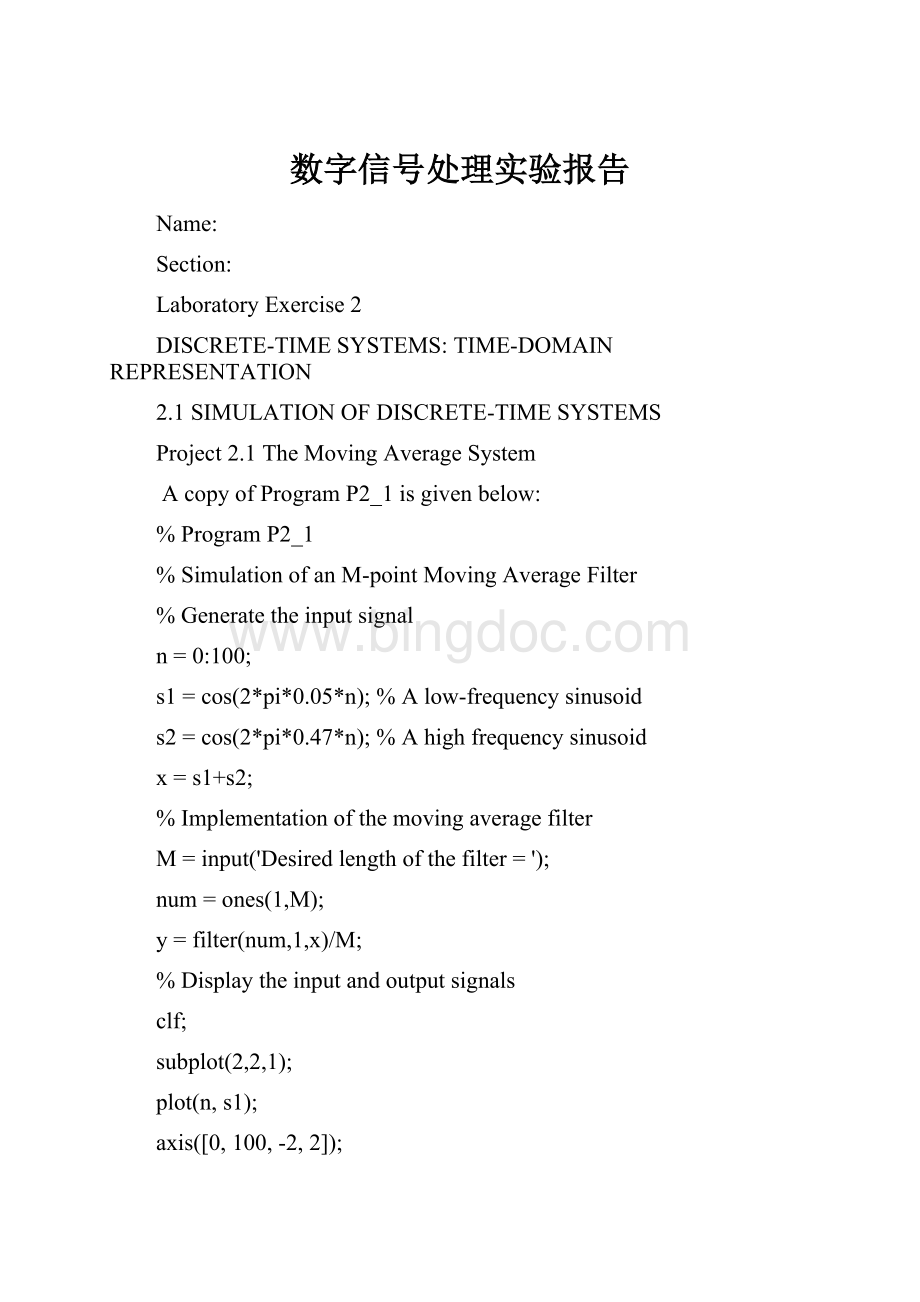数字信号处理实验报告.docx
《数字信号处理实验报告.docx》由会员分享,可在线阅读,更多相关《数字信号处理实验报告.docx(21页珍藏版)》请在冰点文库上搜索。

数字信号处理实验报告
Name:
Section:
LaboratoryExercise2
DISCRETE-TIMESYSTEMS:
TIME-DOMAINREPRESENTATION
2.1SIMULATIONOFDISCRETE-TIMESYSTEMS
Project2.1TheMovingAverageSystem
AcopyofProgramP2_1isgivenbelow:
%ProgramP2_1
%SimulationofanM-pointMovingAverageFilter
%Generatetheinputsignal
n=0:
100;
s1=cos(2*pi*0.05*n);%Alow-frequencysinusoid
s2=cos(2*pi*0.47*n);%Ahighfrequencysinusoid
x=s1+s2;
%Implementationofthemovingaveragefilter
M=input('Desiredlengthofthefilter=');
num=ones(1,M);
y=filter(num,1,x)/M;
%Displaytheinputandoutputsignals
clf;
subplot(2,2,1);
plot(n,s1);
axis([0,100,-2,2]);
xlabel('Timeindexn');ylabel('Amplitude');
title('Signal#1');
subplot(2,2,2);
plot(n,s2);
axis([0,100,-2,2]);
xlabel('Timeindexn');ylabel('Amplitude');
title('Signal#2');
subplot(2,2,3);
plot(n,x);
axis([0,100,-2,2]);
xlabel('Timeindexn');ylabel('Amplitude');
title('InputSignal');
subplot(2,2,4);
plot(n,y);
axis([0,100,-2,2]);
xlabel('Timeindexn');ylabel('Amplitude');
title('OutputSignal');
axis;
Answers:
Q2.1TheoutputsequencegeneratedbyrunningtheaboveprogramforM=2withx[n]=s1[n]+s2[n]astheinputisshownbelow.
Thecomponentoftheinputx[n]suppressedbythediscrete-timesystemsimulatedbythisprogramis–s2
Q2.2ProgramP2_1ismodifiedtosimulatetheLTIsystemy[n]=0.5(x[n]–x[n–1])andprocesstheinputx[n]=s1[n]+s2[n]resultingintheoutputsequenceshownbelow:
s3=cos(2*pi*0.05*(n-1));
s4=cos(2*pi*0.47*(n-1));
z=s3+s4;
y=0.5*(x-z);
TheeffectofchangingtheLTIsystemontheinputis-
Project2.2(Optional)ASimpleNonlinearDiscrete-TimeSystem
AcopyofProgramP2_2isgivenbelow:
%ProgramP2_2
%Generateasinusoidalinputsignal
clf;
n=0:
200;
x=cos(2*pi*0.05*n);
%Computetheoutputsignal
x1=[x00];%x1[n]=x[n+1]
x2=[0x0];%x2[n]=x[n]
x3=[00x];%x3[n]=x[n-1]
y=x2.*x2-x1.*x3;
y=y(2:
202);
%Plottheinputandoutputsignals
subplot(2,1,1)
plot(n,x)
xlabel('Timeindexn');ylabel('Amplitude');
title('InputSignal')
subplot(2,1,2)
plot(n,y)
xlabel('Timeindexn');ylabel('Amplitude');
title('Outputsignal');
Answers:
Q2.5Thesinusoidalsignalswiththefollowingfrequenciesastheinputsignalswereusedtogeneratetheoutputsignals:
Theoutputsignalsgeneratedforeachoftheaboveinputsignalsaredisplayedbelow:
Theoutputsignalsdependonthefrequenciesoftheinputsignalaccordingtothefollowingrules:
Thisobservationcanbeexplainedmathematicallyasfollows:
Project2.3LinearandNonlinearSystems
AcopyofProgramP2_3isgivenbelow:
%ProgramP2_3
%Generatetheinputsequences
clf;
n=0:
40;
a=2;b=-3;
x1=cos(2*pi*0.1*n);
x2=cos(2*pi*0.4*n);
x=a*x1+b*x2;
num=[2.24032.49082.2403];
den=[1-0.40.75];
ic=[00];%Setzeroinitialconditions
y1=filter(num,den,x1,ic);%Computetheoutputy1[n]
y2=filter(num,den,x2,ic);%Computetheoutputy2[n]
y=filter(num,den,x,ic);%Computetheoutputy[n]
yt=a*y1+b*y2;
d=y-yt;%Computethedifferenceoutputd[n]
%Plottheoutputsandthedifferencesignal
subplot(3,1,1)
stem(n,y);
ylabel('Amplitude');
title('OutputDuetoWeightedInput:
a\cdotx_{1}[n]+b\cdotx_{2}[n]');
subplot(3,1,2)
stem(n,yt);
ylabel('Amplitude');
title('WeightedOutput:
a\cdoty_{1}[n]+b\cdoty_{2}[n]');
subplot(3,1,3)
stem(n,d);
xlabel('Timeindexn');ylabel('Amplitude');
title('DifferenceSignal');
Answers:
Q2.7Theoutputsy[n],obtainedwithweightedinput,andyt[n],obtainedbycombiningthetwooutputsy1[n]andy2[n]withthesameweights,areshownbelowalongwiththedifferencebetweenthetwosignals:
Thetwosequencesare–same;wecanregard10(-15)as0
Thesystemis–alinersystem
Q2.9Program2_3wasrunwiththefollowingnon-zeroinitialconditions-ic=[22];
Theplotsgeneratedareshownbelow-
Basedontheseplotswecanconcludethatthesystemwithnonzeroinitialconditionsis–assameasthezeroinitialconditionwiththetimegone
Project2.4Time-invariantandTime-varyingSystems
AcopyofProgramP2_4isgivenbelow:
%ProgramP2_4
%Generatetheinputsequences
clf;
n=0:
40;D=10;a=3.0;b=-2;
x=a*cos(2*pi*0.1*n)+b*cos(2*pi*0.4*n);
xd=[zeros(1,D)x];
num=[2.24032.49082.2403];
den=[1-0.40.75];
ic=[00];%Setinitialconditions
%Computetheoutputy[n]
y=filter(num,den,x,ic);
%Computetheoutputyd[n]
yd=filter(num,den,xd,ic);
%Computethedifferenceoutputd[n]
d=y-yd(1+D:
41+D);
%Plottheoutputs
subplot(3,1,1)
stem(n,y);
ylabel('Amplitude');
title('Outputy[n]');grid;
subplot(3,1,2)
stem(n,yd(1:
41));
ylabel('Amplitude');
title(['OutputduetoDelayedInputx[n?
num2str(D),']']);grid;
subplot(3,1,3)
stem(n,d);
xlabel('Timeindexn');ylabel('Amplitude');
title('DifferenceSignal');grid;
Answers:
Q2.12Theoutputsequencesy[n]andyd[n-10]generatedbyrunningProgramP2_4areshownbelow-
Thesetwosequencesarerelatedasfollows–same,theoutputdon’tchangewiththetime
Thesystemis-Timeinvariantsystem
Q2.15Theoutputsequencesy[n]andyd[n-10]generatedbyrunningProgramP2_4fornon-zeroinitialconditionsareshownbelow-ic=[52];
Thesetwosequencesarerelatedasfollows–justasthesequencesabove
Thesystemis–notrelatedtotheinitialconditions
2.2LINEARTIME-INVARIANTDISCRETE-TIMESYSTEMS
Project2.5ComputationofImpulseResponsesofLTISystems
AcopyofProgramP2_5isshownbelow:
%ProgramP2_5
%Computetheimpulseresponsey
clf;
N=40;
num=[2.24032.49082.2403];
den=[1-0.40.75];
y=impz(num,den,N);
%Plottheimpulseresponse
stem(y);
xlabel('Timeindexn');ylabel('Amplitude');
title('ImpulseResponse');grid;
Answers:
Q2.19Thefirst41samplesoftheimpulseresponseofthediscrete-timesystemofProject2.3generatedbyrunningProgramP2_5isgivenbelow:
Project2.6CascadeofLTISystems
AcopyofProgramP2_6isgivenbelow:
%ProgramP2_6
%CascadeRealization
clf;
x=[1zeros(1,40)];%Generatetheinput
n=0:
40;
%Coefficientsof4thordersystem
den=[11.62.281.3250.68];
num=[0.06-0.190.27-0.260.12];
%Computetheoutputof4thordersystem
y=filter(num,den,x);
%Coefficientsofthetwo2ndordersystems
num1=[0.3-0.20.4];den1=[10.90.8];
num2=[0.2-0.50.3];den2=[10.70.85];
%Outputy1[n]ofthefirststageinthecascade
y1=filter(num1,den1,x);
%Outputy2[n]ofthesecondstageinthecascade
y2=filter(num2,den2,y1);
%Differencebetweeny[n]andy2[n]
d=y-y2;
%Plotoutputanddifferencesignals
subplot(3,1,1);
stem(n,y);
ylabel('Amplitude');
title('Outputof4thorderRealization');grid;
subplot(3,1,2);
stem(n,y2)
ylabel('Amplitude');
title('OutputofCascadeRealization');grid;
subplot(3,1,3);
stem(n,d)
xlabel('Timeindexn');ylabel('Amplitude');
title('DifferenceSignal');grid;
Answers:
Q2.23Theoutputsequencesy[n],y2[n],andthedifferencesignald[n]generatedbyrunningProgramP2_6areindicatedbelow:
Therelationbetweeny[n]andy2[n]is–y[n]istheConvolutionofy2[n]andy1[n]
The4thordersystemcandothesamejobasthecascadesystem
Q2.24ThesequencesgeneratedbyrunningProgramP2_6withtheinputchangedtoasinusoidalsequenceareasfollows:
x=sin(2*pi*0.05*n);
Therelationbetweeny[n]andy2[n]inthiscaseis–sameastherelationabove
Project2.7Convolution
AcopyofProgramP2_7isreproducedbelow:
%ProgramP2_7
clf;
h=[321-210-403];%impulseresponse
x=[1-23-4321];%inputsequence
y=conv(h,x);
n=0:
14;
subplot(2,1,1);
stem(n,y);
xlabel('Timeindexn');ylabel('Amplitude');
title('OutputObtainedbyConvolution');grid;
x1=[xzeros(1,8)];
y1=filter(h,1,x1);
subplot(2,1,2);
stem(n,y1);
xlabel('Timeindexn');ylabel('Amplitude');
title('OutputGeneratedbyFiltering');grid;
Answers:
Q2.28Thesequencesy[n]andy1[n]generatedbyrunningProgramP2_7areshownbelow:
Thedifferencebetweeny[n]andy1[n]is-same
Thereasonforusingx1[n]astheinput,obtainedbyzero-paddingx[n],forgeneratingy1[n]is–thelengthofxis7,butthelengthoftheConvolutionis14,andn=14,weneedthelengthoffiltertobe14
Project2.8StabilityofLTISystems
AcopyofProgramP2_8isgivenbelow:
%ProgramP2_8
%Stabilitytestbasedonthesumoftheabsolute
%valuesoftheimpulseresponsesamples
clf;
num=[1-0.8];den=[11.50.9];
N=200;
h=impz(num,den,N+1);
parsum=0;
fork=1:
N+1;
parsum=parsum+abs(h(k));
ifabs(h(k))<10^(-6),break,end
end
%Plottheimpulseresponse
n=0:
N;
stem(n,h)
xlabel('Timeindexn');ylabel('Amplitude');
%Printthevalueofabs(h(k))
disp('Value=');disp(abs(h(k)));
Answers:
Q2.32Thediscrete-timesystemofProgramP2_8is-
[h,t]=impz(hd)computestheinstantaneousimpulseresponseofthediscrete-timefilterhdchoosingthenumberofsamplesforyou,andreturnstheresponseincolumnvectorhandavectoroftimesorsampleintervalsintwhere(t=[012...]').impzreturnsamatrixhifhdisavector.Eachcolumnofthematrixcorrespondstoonefilterinthevector.Whenhdisavectorofdiscrete-timefilters,impzreturnsthematrixh.Eachcolumnofhcorrespondstoonefilterinthevectorhd.
impz(hd)usesFVTooltoplottheimpulseresponseofthediscrete-timefilterhd.Ifhdisavectoroffilters,impzplotstheresponseandforeachfilterinthevector.
TheimpulseresponsegeneratedbyrunningProgramP2_8isshownbelow:
Thevalueof|h(K)|hereis-1.6761e-005
Fromthisvalueand